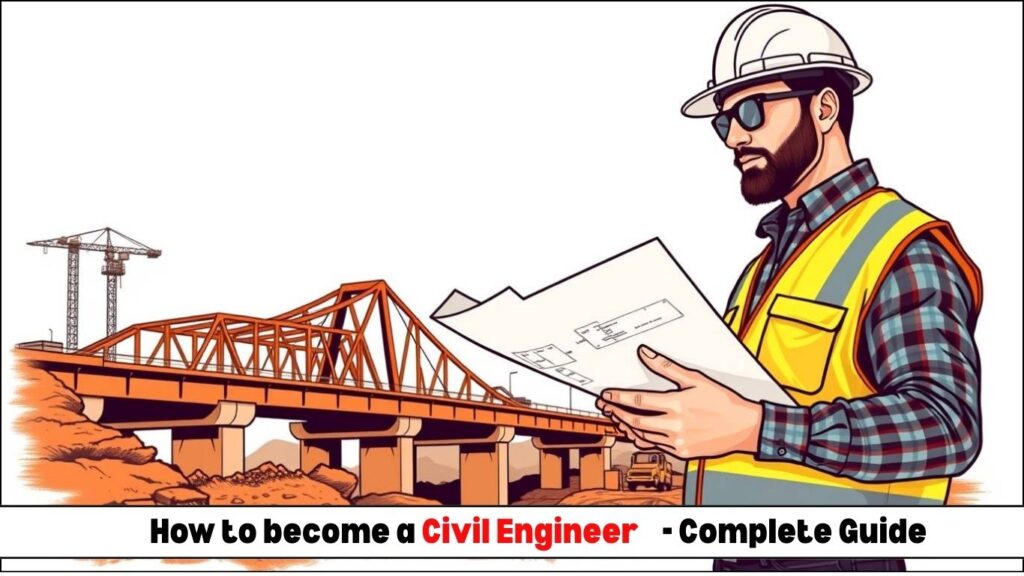
Introduction
Civil Engineers are the unsung heroes of modern civilization, designing and maintaining the infrastructure that shapes our world—from bridges and skyscrapers to highways and water systems. With urbanization and climate change driving demand, this profession offers job stability, high salaries, and global opportunities.
This comprehensive guide covers:
✅ History of Civil Engineering
✅ Salary Expectations (Entry-Level to Senior Roles)
✅ Key Roles & Specializations
✅ Essential Qualifications & Skills
✅ How to Get Started (Step-by-Step Guide)
✅ Future Trends & Job Outlook
Let’s explore this foundational career in detail!
1. The History of Civil Engineering
Ancient Beginnings (Pre-1000 CE)
- 3000 BCE: Mesopotamians built ziggurats and irrigation systems.
- 2700 BCE: Egyptians engineered the Great Pyramid of Giza.
- 312 BCE: Romans constructed the Appian Way and aqueducts.
Middle Ages to Industrial Revolution (1000-1800 CE)
- 1200s: Gothic cathedrals like Notre-Dame showcased advanced masonry.
- 1771: John Smeaton became the first self-proclaimed “Civil Engineer.”
Modern Era (1800s-Present)
- 1819: Institution of Civil Engineers (ICE) founded in London.
- 1884: Steel-frame skyscrapers emerged (Home Insurance Building, Chicago).
- 1950s-Present: Computer-aided design (CAD), sustainable materials, and mega-projects (Burj Khalifa, Three Gorges Dam).
Today, civil engineers tackle climate-resilient infrastructure and smart cities.
2. Civil Engineer Salary Expectations
Salaries vary by specialization, experience, and location:
| Experience Level | Average Salary (Annual) |
|---|---|
| Entry-Level (0-2 yrs) | $60,000 – $75,000 |
| Mid-Level (3-7 yrs) | $75,000 – $100,000 |
| Senior-Level (8+ yrs) | $100,000 – $140,000+ |
| Project Managers | $120,000 – $180,000+ |
Top-Paying Specializations
✔ Petroleum Civil Engineering ($130K+)
✔ Construction Management ($90K-$150K)
✔ Structural Engineering ($85K-$130K)
✔ Transportation Engineering ($80K-$120K)
Note: Government jobs offer stability, while private firms pay higher salaries.
3. Roles & Responsibilities
A. Design & Planning
- Create blueprints using AutoCAD, Revit, or BIM.
- Ensure compliance with safety codes (ACI, AISC, ISO).
B. Construction Supervision
- Oversee site execution, budgets, and timelines.
- Resolve technical issues (e.g., foundation challenges).
C. Infrastructure Maintenance
- Inspect bridges, dams, and roads for structural integrity.
- Implement retrofitting for earthquake resistance.
D. Specializations
- Structural: Skyscrapers, stadiums.
- Geotechnical: Soil analysis, tunnels.
- Environmental: Water treatment, pollution control.
- Transportation: Highways, airports.
4. Qualifications & Skills
A. Educational Background
- Bachelor’s Degree in Civil Engineering (ABET-accredited).
- Master’s Degree for research or niche roles (e.g., seismic engineering).
B. Licenses & Certifications
✔ Professional Engineer (PE) License (mandatory for leadership roles).
✔ LEED Certification (for sustainable design).
✔ PMP Certification (for project management).
C. Technical Skills
✔ CAD/BIM Software: AutoCAD, Revit, Civil 3D
✔ Analysis Tools: ETABS, SAP2000, STAAD.Pro
✔ GIS & Surveying: ArcGIS, Total Station
D. Soft Skills
✔ Problem-Solving (for on-site challenges).
✔ Leadership (managing teams).
✔ Communication (client/stakeholder reports).
5. How to Get Started
Step 1: Earn a Degree
- Pursue a B.Tech/B.E. in Civil Engineering.
- Join student chapters (ASCE, ICE).
Step 2: Gain Experience
- Intern with construction firms or government agencies.
- Volunteer for NGO infrastructure projects.
Step 3: Get Licensed
- Pass the Fundamentals of Engineering (FE) Exam.
- After 4 years, take the PE Exam.
Step 4: Apply for Jobs
- Entry-Level Roles:
- Site Engineer
- Design Engineer
- Urban Planner
Step 5: Advance Your Career
- Specialize in AI for construction or green building.
- Pursue an MBA for executive roles.
6. Future of Civil Engineering
Emerging Trends
🚀 Smart Cities: IoT-enabled infrastructure.
🚀 3D-Printed Buildings: Faster, cheaper construction.
🚀 Climate-Resilient Design: Flood-resistant roads.
🚀 Modular Construction: Prefab skyscrapers.
Job Outlook
- 5% growth by 2030 (steady demand).
- High need for disaster-proof and sustainable infrastructure.
Final Thoughts
Civil Engineering is ideal if you:
✓ Want to build tangible, lasting structures.
✓ Enjoy physics, math, and fieldwork.
✓ Seek a recession-proof career.
Pro Tip: Learn Python for automation and BIM for future-ready skills.
Ready to Build Tomorrow?
📌 Comment below for free study resources!
📌 Share this guide with aspiring engineers!













Post Comment